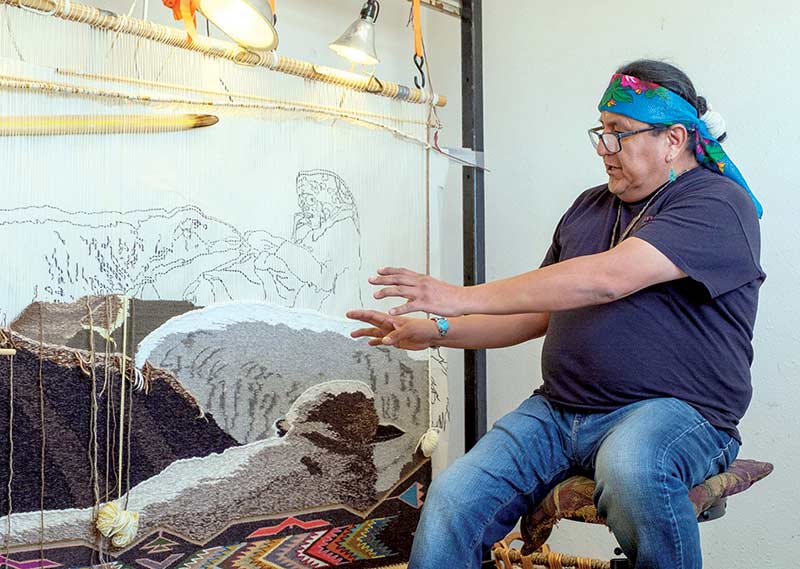
The mother of all rugs

Special to the Times | Ray Landry Roy Kady talks about a European tapestry technique he uses at his Teec Nos Po home.
Fiber artist creates a fitting tribute to his first mentor

Special to the Times | Ray Landry
Roy Kady talks about a European tapestry technique he uses at his Teec Nos Po home.
T’IIS NAZBAS, Ariz.
Roy Kady’s passions are woven into his work: birds, mountains, Navajo symbols, the colors of the desert.
But there was one subject so close to his heart, even the master weaver couldn’t translate it into cloth.
Until now.
“This one was waiting to be woven,” he said of his current project. “It’s the right time.”
It’s been a little over four years since Kady’s mother, Mary K. Clah, passed away. She was Kady’s teacher, his confidante, his housemate and best friend — the one who bequeathed him her little farm and her beloved flock of sheep and goats.
It was Mary’s time to go. She was in her late 80s and suffering from dementia. Still, Kady found it impossible to say goodbye.
He could hardly look at her loom. He wouldn’t use the balls of naturally dyed yarn left over from her own rugs, tantalizing though they were.
“I struggled with it,” he said. But “This year marked the time for me to release her. This is my farewell.”
He nodded to a loom that takes up almost an entire wall of a room in his uncle’s modest house in T’iis Nazbas. On it, an incredible scene is taking shape: A flock of multicolored sheep and goats gathers around a gnarled woman, who reaches out to them with an expression of pure love.
Heavenly rays of sunlight filter down, striping the fleece of the animals and illuminating the elder’s kind face.
It’s based on a photograph Kady took of his mother shortly before she died.
“The sheep were always drawn to her, even when she didn’t have anything in her hand,” he reminisced. “They were her lifeway.”
Mary was kept out of school, he explained, because her parents needed her help with their own flock. Whenever they heard the BIA men were coming around, looking for truants, “They’d say, ‘Why don’t you take the sheep to the mountains today?’” Kady said with a smile. “She led sort of a hidden life.”
Her marriage to Kady’s father was not an easy one. He was a policeman and rarely came home. It was rumored he had at least one other family.
If it bothered Mary, she didn’t show it. Her life was one of relentless hard work, seasonal routines, and finding beauty in the smallest of things.
“She was always outside,” Kady recalled. “If she wasn’t planting, she was building a chicken coop, digging a root cellar, packing things for the annual move to the mountains with the sheep.”
She was a sought-after herbalist, an instinctual horsewoman. She would lend a hand to anybody who needed it, and when it was her turn to harvest, she wouldn’t hesitate to call upon her many friends, who happily responded.
And always, always, she had a loom.
“She would just nail some boards together, until my brother came home from Oklahoma and welded some pipes together to make her a sturdy one,” Kady recalled, tearing up just a little.
Not only in subject matter but in method, this weaving marks a culmination for Kady. He is bringing to bear every technique he ever learned.
“You’ll notice I’m weaving in sections,” he said, “weaving at different angles, twisting together different colors of yarn, using some thick and some very fine yarns.”
The photographic design is reminiscent of the work of one of his mentors, Swedish fiber artist Helena Hernmarck. But unlike Hernmarck, who usually strives for the stark realism of a photograph, Kady is editing a bit and inserting some of his usual whimsy.
The border is a pattern taken from one of Mary’s own rugs. He’s going to make her jacket purple, her favorite color.
“I’m getting rid of the wheelchair,” he said, “and replacing it with a regular chair.”
And instead of the barn side in the photograph, the background will be a blue sky, filled with birds and at least one butterfly.
“My mom used to say that if a butterfly lands on you voluntarily, you’ll acquire wealth,” Kady explained.
The weave will be a combination of textural techniques he learned 10 years ago in a French tapestry class.
“I know some people will say it’s not Navajo weaving,” said Kady, “but to me it’s using every tool available to create what I want to convey. I could spend my life doing T’iis Nazbas pattern rugs, but why? It’s already been done. This piece … no one will every copy it.”
Kady intends to enter the piece into the Heard Museum’s juried show this weekend as part of the Phoenix museum’s annual Indian Fair and Market.
As for its ultimate fate, “I will make sure it ends up in the right hands,” he promised. “I’d like to see it in a museum somewhere, where people can enjoy it and honor my mom and all Navajo women.”
To read the full article, pick up your copy of the Navajo Times at your nearest newsstand Thursday mornings!
Are you a digital subscriber? Read the most recent three weeks of stories by logging in to your online account.







 Highway 264,
Highway 264, I-40, WB @ Winslow
I-40, WB @ Winslow